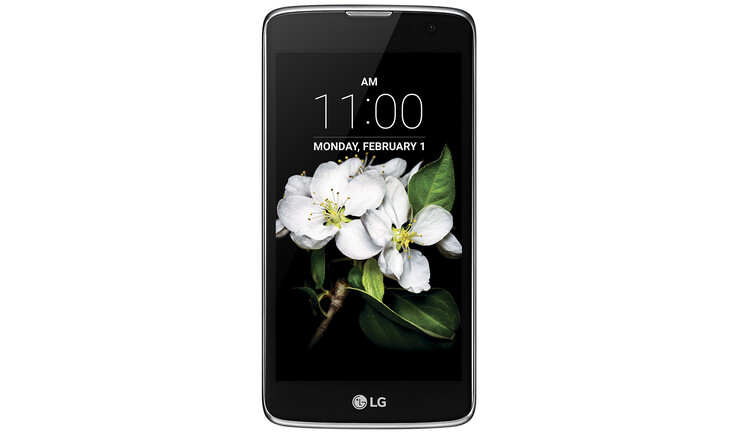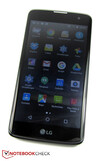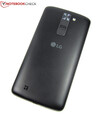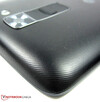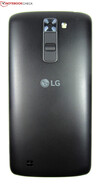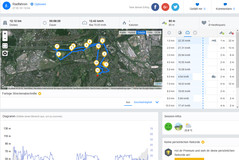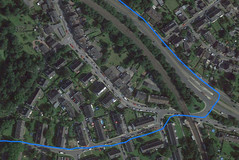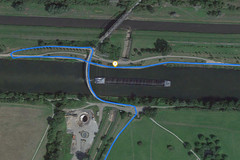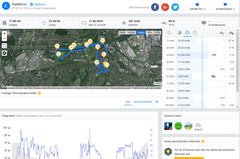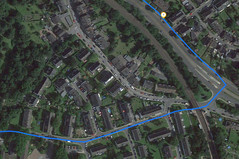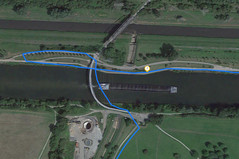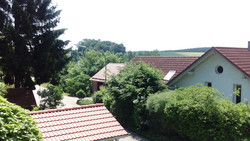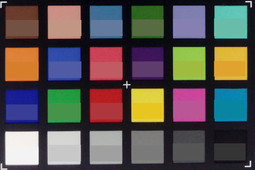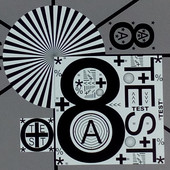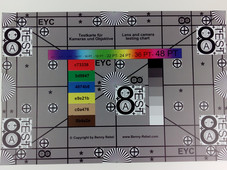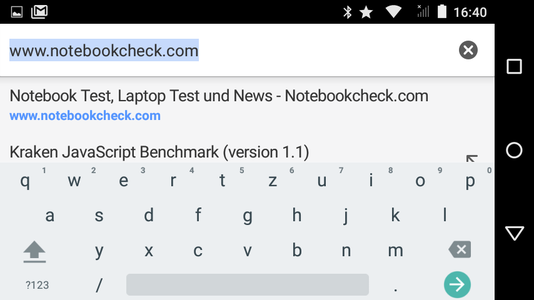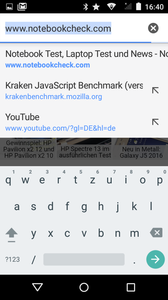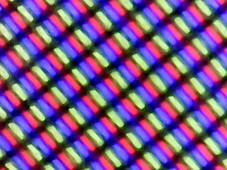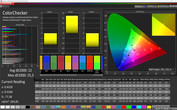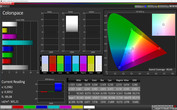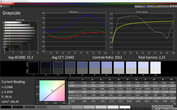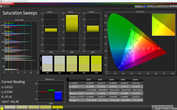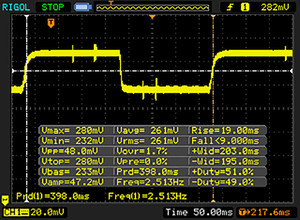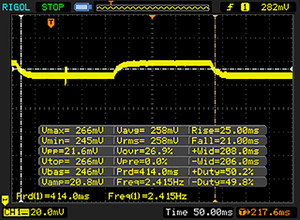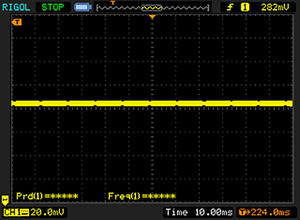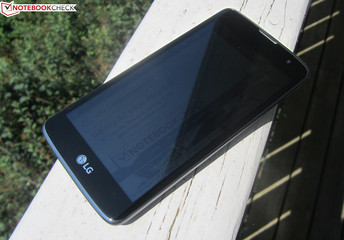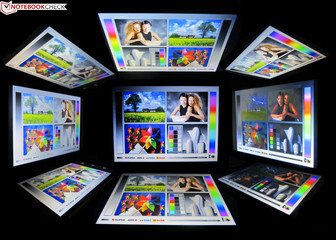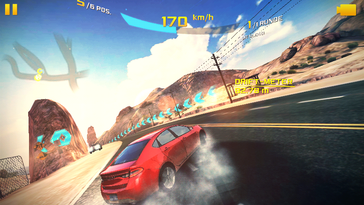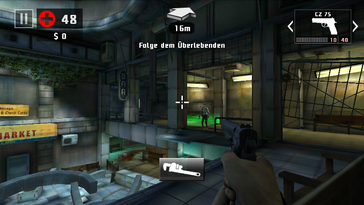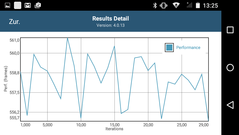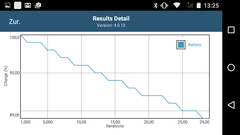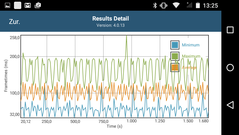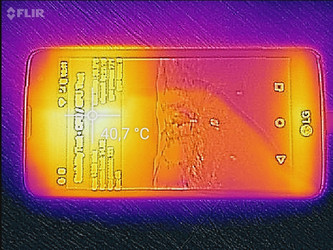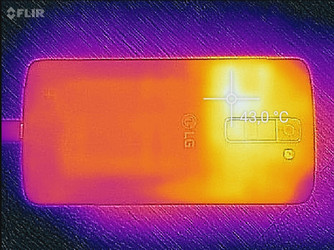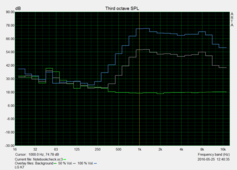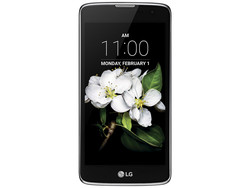LG K7 Smartphone Review

For the original German review, see here.
The LG K7 is an entry-level smartphone mainly designed for selfies. For that purpose, LG has equipped the smartphone with two 5 MP cameras, an LED flash as well as controls on the back. The K7 is powered by a quad-core MediaTek MT6580M Soc and an ARM Mali-400 MP2 GPU, so the performance looks to be decent as well - at least on paper.
The LG competes with similarly-equipped smartphones. For our comparison, we'll also take a look Acer Liquid Jade Z, the LG Bello II, the Motorola Moto G (3. Gen. 2015), the Samsung Galaxy J5, and the ZTE Blade A452.
Case
From a design standpoint, the LG K7 reminds us a lot of the sibling LG Bello II, which also features a 5-inch display. The case is made from plastic and is available in either black or white. The design feels quite upscale - the slightly rough back cover contributes here as well, since it gives the fingers something to hold on to. The back is home to the power button and the volume rocker switch. Removing the back cover allows access to the swappable Lithium Ion battery and the Nano-SIM and MicroSD card slots.
Connectivity
The LG K7 is powered by a MediaTek MT6580M processor - an entry-level quad-core SoC with the cores running at 1.3 GHz. An ARM Mali-400 MP2 GPU and 1 GB RAM round out the package. The storage capacity is 8 GB, of which only 3.3 GB are available to the user. The MicroSD card slot allows cards of up to 32 GB, but the card storage can't be added to the internal flash storage. The smartphone doesn't support App2SD, either, so the user is forced to content with the meager internal storage.
Software
LG's K7 runs a - at the time of writing not quite current - version of Android (5.1 Lollipop). In addition to standard programs like Google Apps, LG is fairly conservative with their own applications. Included are a file manager, SMS toolkit, a sound recorder, voice search, and a FM radio, which uses the included headphones as antenna.
Communication & GPS
The LG K7 utilizes GSM quadband (850/900/1.800/1900 MHz) as well as UMTS quadband (850/900/1900/2100 MHz). According to the manufacturer, HSDPA allows for download speeds of up to 21 MBit/s; HSUPA tops out at 5.76 MBit/s. Local network connectivity is established via WLAN 802.11 b/g/n. For short distances, Bluetooth 4.1 is on board as well. When we connected to WiFi, the LG K7 transmitted data at the speed we expected, although the signal strength had decreased to about 50 % 10 meters from the router.
The integrated GPS is very precise (within a few meters) both outdoors as well as inside. Our 12 km bicycle test track, which we completed taking both the review smartphone as well as the professional GPS Garmin Edge 500 along, confirmed the results. Even though the smartphone was a literally "of course" at times, the final discrepancy was only 140 meters - definitely precise enough for daily use.
Telephone & Voice Quality
The LG K7 sounds quite decent while making phone calls in 2G and 3G networks. No matter if the call partner used a mobile phone or a land line: each user could understand and hear the other clearly. Using the speakerphone does impede the quality at the other end a little, but that's to be expected. The phone app with the contact list and the quick-dial function isn't anything special, but offers solid Android performance.
Cameras
The LG K7 is equipped with two 5 MP cameras with a resolution of 2560 x 1920 pixels. Users who prefer the 16:9 instead of the 4:3 ratio have to use the 4 MP setting (2560 x 1440 pixels). Both cameras can record videos at up to 30 fps - the rear-facing camera at Full-HD resolution, the front-facing camera at a maximum of 640 x 480 pixels.
LG advertises the K7 as a "selfie" smartphone and has included a few extras for that purpose: selfies, for example, can be triggered via a hand motion (clenching a fist). In addition, the backlight function allows the screen to be "framed" by a white border, which helps taking self portraits even in marginal lighting conditions. Both cameras also take a picture when the user taps anywhere on the display.
Subjectively, the main camera takes good pictures which look vivid and life-like. The camera does lack a tiny little bit of detail sharpness though and darker scenes can be affected by some amount of noise and graininess. The rear-facing camera does take much better pictures than the front-facing camera, which isn't capable of sharp photos even in excellent lighting conditions. The resulting photos always look soft. The K7's selfie-qualities are therefore not quite as outstanding as LG would want to make us believe.
An analysis with the ColorChecker Passport shows that the K7 tends to over-saturates colors and makes them look more vivid than they actually are. The test chart - which we photographed under controlled conditions - is fairly sharp, although noise is visible.
Accessories & Warranty
LG includes a modular power adapter, a Micro-USB cable and a headphone. Dedicated accessories are not offered. In Germany, the K7 is protected against defects for 24 months. The swappable battery and the included accessories are only covered for 6 months.
Input Devices & Operation
The power button and the volume rocker switch are located on the back, directly below the camera and not on the side of the phone, which is more common. Once we got used to the arrangement, we were able to operate the LG K7 as quickly as a "normal" smartphone - in particular, because the physical buttons are easy to locate and errors therefore a rarity.
The quad-core SoC offers enough performance to navigate through the Android windows and menus in a timely fashion. Rarely did we encounter any lag - if so, it happened during the start of an app or when switching applications. This occurred only a few times during the review period, so it's not really an issue. The virtual keyboard reacts quickly to inputs. The screen content is also visible in landscape mode, as the virtual keyboard only takes up about half of the screen.
Display
Entry-level phones are not always equipped with HD displays. At least the LG K7 manages the "lower" 720p HD resolution, which results in 854 x 480 pixels on its 5-inch display. Because of the decent pixel density of 196 ppi, it's not necessarily noticeable that the smartphone has a lower resolution. The competitors Acer Liquid Jade Z, Motorola Moto G (3. Gen. 2015), Samsung Galaxy J5 and ZTE Blade A452 offer 1280 x 720 pixels; only the LG Bello II features the same resolution as the review candidate.
The LG K7 scores with a low black point of 0.26 cd/m², which results in a contrast ratio of 1:1185 and vivid colors. The average brightness of 300 cd/m² is bright enough for indoor use, but outdoors the reserves are marginal. The brightness distribution of 93 % could be a little better as well, but i'ts not really noticeable.
| |||||||||||||||||||||||||
Brightness Distribution: 93 %
Center on Battery: 308 cd/m²
Contrast: 1185:1 (Black: 0.26 cd/m²)
ΔE ColorChecker Calman: 12 | ∀{0.5-29.43 Ø4.78}
ΔE Greyscale Calman: 15.3 | ∀{0.09-98 Ø5}
Gamma: 2.15
CCT: 22440 K
| LG K7 IPS, 854x480, 5" | Acer Liquid Jade Z IPS, 1280x720, 5" | LG Bello II IPS, 854x480, 5" | Motorola Moto G 3. Gen 2015 XT1541 IPS, 1280x720, 5" | Samsung Galaxy J5 Super AMOLED, 1280x720, 5" | ZTE Blade A452 IPS, 1280x720, 5" | |
|---|---|---|---|---|---|---|
| Screen | 8% | 14% | 14% | 32% | -1% | |
| Brightness middle (cd/m²) | 308 | 343 11% | 333 8% | 418 36% | 349 13% | 446 45% |
| Brightness (cd/m²) | 300 | 340 13% | 333 11% | 407 36% | 353 18% | 411 37% |
| Brightness Distribution (%) | 93 | 93 0% | 90 -3% | 95 2% | 93 0% | 83 -11% |
| Black Level * (cd/m²) | 0.26 | 0.39 -50% | 0.23 12% | 0.49 -88% | 0.65 -150% | |
| Contrast (:1) | 1185 | 879 -26% | 1448 22% | 853 -28% | 686 -42% | |
| Colorchecker dE 2000 * | 12 | 5.59 53% | 9.41 22% | 3.92 67% | 5.22 56% | 6.29 48% |
| Colorchecker dE 2000 max. * | 25.3 | |||||
| Greyscale dE 2000 * | 15.3 | 7.25 53% | 11.15 27% | 3.81 75% | 3.96 74% | 5.58 64% |
| Gamma | 2.15 102% | 2.41 91% | 2.17 101% | 2.27 97% | 2.08 106% | 2.04 108% |
| CCT | 22440 29% | 7361 88% | 12959 50% | 7361 88% | 7308 89% | 7636 85% |
* ... smaller is better
Whats quite out of the ordinary, however, are the parameters of the display. According to our measurements, LG installed a display which is just "off" in more or less every single aspects. The graylevel deviation is downright awful with a DeltaE of 15.3 and the colors aren't much better (DeltaE of 12). In a nutshell: the LG K7 displays the screen contents in a very colorful and not very natural fashion. On a day-to-day basis, that's not really noticeable - with one exception: the color temperature if 22440K is almost four times of what it should be (6500K). The LG K7's display is very "cool", so even summer, sand, and beach movies can look a little chilly.
Display Response Times
| ↔ Response Time Black to White | ||
|---|---|---|
| 28 ms ... rise ↗ and fall ↘ combined | ↗ 19 ms rise | |
| ↘ 9 ms fall | ||
| The screen shows relatively slow response rates in our tests and may be too slow for gamers. In comparison, all tested devices range from 0.1 (minimum) to 240 (maximum) ms. » 70 % of all devices are better. This means that the measured response time is worse than the average of all tested devices (20.2 ms). | ||
| ↔ Response Time 50% Grey to 80% Grey | ||
| 46 ms ... rise ↗ and fall ↘ combined | ↗ 25 ms rise | |
| ↘ 21 ms fall | ||
| The screen shows slow response rates in our tests and will be unsatisfactory for gamers. In comparison, all tested devices range from 0.165 (minimum) to 636 (maximum) ms. » 78 % of all devices are better. This means that the measured response time is worse than the average of all tested devices (31.6 ms). | ||
Screen Flickering / PWM (Pulse-Width Modulation)
| Screen flickering / PWM not detected | |||
In comparison: 53 % of all tested devices do not use PWM to dim the display. If PWM was detected, an average of 8108 (minimum: 5 - maximum: 343500) Hz was measured. | |||
With the brightness turned up to the maximum of 300 cd/m², the K7 is just bright enough to be used outside. As long as the user keeps the phone in portrait orientation and tries to remain in the shade, this doesn't change. In landscape mode, the display darkens significantly when it's turned to the side just slightly - even though LG uses an IPS display, which should offer great viewing angle stability. At very shallow angles, the screen content actually inverts completely.
Performance
The K7 comes equipped with a quad-core MediaTek MT6580M SoC, which has Cortex A7 cores running at 1.3 GHz each. If we were trying to find a category for this SoC, the answer would be "entry-level smartphones". The performance is solid, but far from great. The 1 GB of RAM - which is pretty stingy - and the not exactly brand-new GPU ARM Mali-400 MP2 round out the package.
The LG K7 of course doesn't set any performance records. The smartphone does pretty decently, but performs slower than the competition in many benchmarks. The one exception is AnTuTu: here, the smartphone is about as fast as the LG Bello II and the ZTE Blade A452. The K7 also garners one of the top spots when running the 3DMark 2013 and GFXBench, but has no chance whatsoever against the Acer Liquid Jade Z, which scores the best overall. For Geekbench 3, PCMark for Android and BaseMark OS II, the K7 simply doesn't earn enough points to close the gap to the competition.
The average data transfer rates show rather ambivalent performance. One one hand, 128.1 MB/s for sequential reads and 15.6 MB/s for 4K reads are pretty good - but the opposite is true for write operations: the result of 8.2 MB/s is - together with the LG Bello II and the ZTE Blade A452 - only good enough for the last place. The Motorola Moto G (3. Gen. 2015), the Samsung Galaxy J5 and the Acer Liquid Jade Z are significantly faster. None of the smartphones does that well as far as 4K writes are concerned and the LG K7 (which averaged 5.3 MB/s) isn't even the slowest here.
The performance of the card reader is middling as well. With our MicroSD reference card Toshiba Exceria Pro M401 (THN-M401S0640E2: reads up to 95 MB/s, writes up to 80 MB/s), we recorded 37.8 MB/s for sequential reads and 19.3 MB/s for sequential writes, which is way short of what this card is capable of.
| AnTuTu v6 - Total Score (sort by value) | |
| LG K7 | |
| LG Bello II | |
| ZTE Blade A452 | |
| Geekbench 3 | |
| 64 Bit Single-Core Score (sort by value) | |
| LG K7 | |
| Motorola Moto G 3. Gen 2015 XT1541 | |
| Samsung Galaxy J5 | |
| ZTE Blade A452 | |
| 64 Bit Multi-Core Score (sort by value) | |
| LG K7 | |
| Motorola Moto G 3. Gen 2015 XT1541 | |
| Samsung Galaxy J5 | |
| ZTE Blade A452 | |
| 3DMark | |
| 1280x720 offscreen Ice Storm Unlimited Score (sort by value) | |
| LG K7 | |
| Acer Liquid Jade Z | |
| LG Bello II | |
| Motorola Moto G 3. Gen 2015 XT1541 | |
| Samsung Galaxy J5 | |
| ZTE Blade A452 | |
| 1280x720 offscreen Ice Storm Unlimited Graphics Score (sort by value) | |
| LG K7 | |
| Acer Liquid Jade Z | |
| LG Bello II | |
| Motorola Moto G 3. Gen 2015 XT1541 | |
| Samsung Galaxy J5 | |
| ZTE Blade A452 | |
| 1280x720 offscreen Ice Storm Unlimited Physics (sort by value) | |
| LG K7 | |
| Acer Liquid Jade Z | |
| LG Bello II | |
| Motorola Moto G 3. Gen 2015 XT1541 | |
| Samsung Galaxy J5 | |
| ZTE Blade A452 | |
| GFXBench (DX / GLBenchmark) 2.7 | |
| T-Rex Onscreen (sort by value) | |
| LG K7 | |
| Acer Liquid Jade Z | |
| LG Bello II | |
| Motorola Moto G 3. Gen 2015 XT1541 | |
| ZTE Blade A452 | |
| 1920x1080 T-Rex Offscreen (sort by value) | |
| LG K7 | |
| Acer Liquid Jade Z | |
| LG Bello II | |
| Motorola Moto G 3. Gen 2015 XT1541 | |
| ZTE Blade A452 | |
| PCMark for Android - Work performance score (sort by value) | |
| LG K7 | |
| Acer Liquid Jade Z | |
| Motorola Moto G 3. Gen 2015 XT1541 | |
| Samsung Galaxy J5 | |
The browser benchmarks show similar results as did the synthetic tests and the date transfer tests: the LG K7 does reasonably well here, but can't quite catch up and certainly not surpass any competitors.
| Octane V2 - Total Score (sort by value) | |
| LG K7 | |
| Acer Liquid Jade Z | |
| LG Bello II | |
| Motorola Moto G 3. Gen 2015 XT1541 | |
| Samsung Galaxy J5 | |
| ZTE Blade A452 | |
| Mozilla Kraken 1.1 - Total (sort by value) | |
| LG K7 | |
| Acer Liquid Jade Z | |
| LG Bello II | |
| Motorola Moto G 3. Gen 2015 XT1541 | |
| Samsung Galaxy J5 | |
| ZTE Blade A452 | |
| JetStream 1.1 - Total Score (sort by value) | |
| LG K7 | |
| Motorola Moto G 3. Gen 2015 XT1541 | |
| Samsung Galaxy J5 | |
| ZTE Blade A452 | |
| WebXPRT 2015 - Overall (sort by value) | |
| LG K7 | |
| Motorola Moto G 3. Gen 2015 XT1541 | |
| Samsung Galaxy J5 | |
* ... smaller is better
Gaming
The dual-core ARM Mali-400 MP2 certainly isn't one of the fastest smartphone GPUs out there, but it still offers enough performance for current Android titles. Even more demanding games like Asphalt 8: Airborne and Dead Trigger 2 don't stutter at high details. The responsive acceleration sensor does what's needed and doesn't curtail the gaming experience in any way. Without an additional MicroSD card, not a lot of games can be installed, however. For our review, we had to uninstall a few benchmark apps to make room for Asphalt 8: Airborne and Dead Trigger 2.
| Asphalt 8: Airborne | |||
| Settings | Value | ||
| high | 30 fps | ||
| Dead Trigger 2 | |||
| Settings | Value | ||
| high | 60 fps | ||
Emissions
Temperature
During idle as well as at load the LG K7 remains cool to the touch. Even at maximum load, the temperatures are well-controlled with 36.5 and 34.7 degrees C on the front and the back, respectively. The hottest areas are around 39 degrees C. During idle our instrument recorded a maximum of 33.7 degrees C, but for the most part, temperatures remain around 31 degrees C.
To keep the temperatures in check, LG fortunately doesn't have to resort to any tricks: the SoC isn't subjected to throttling - even during longer periods of stress. During the battery test of the GFXBench benchmark we didn't observer throttling even after 30 subsequent loops. The processor performance fluctuates minimally, but remains consistently high.
(+) The maximum temperature on the upper side is 38.3 °C / 101 F, compared to the average of 35.2 °C / 95 F, ranging from 21.9 to 247 °C for the class Smartphone.
(+) The bottom heats up to a maximum of 39.1 °C / 102 F, compared to the average of 34 °C / 93 F
(±) In idle usage, the average temperature for the upper side is 32 °C / 90 F, compared to the device average of 32.9 °C / 91 F.
Speaker
Like most smartphones, the LG K7 doesn't impress with its sound quality. The mono speaker is located on the back and - thanks to the rounded case design - doesn't sound muffled even when the smartphone is placed on a table. The output reaches 82.9 dB and the sound remains undistorted at maximum volume levels. The pink noise diagram clearly shows that the highs are over-emphasized and mids and especially lows are almost non-existent. The K7 thus sounds pretty anemic and tinny. Once a headphone is connected, the quality improves significantly.
Energy Management
Power Consumption
The swappable Lithium Ion battery has a capacity of 2125 mAh and provides 8.1 Wh. According to LG, the battery should allow for up to 420 hours talk time in 3G networks. The smartphone is pretty frugal with a power consumption of 1.38 watts during idle and 3.59 watts under load. The battery life still isn't impressive, however.
| Off / Standby | |
| Idle | |
| Load |
|
Key:
min: | |
Battery Life
Our practically relevant WLAN test, during which a script opens a new web page every 30 seconds, ended with a recorded run time of 7 hours and 33 minutes, which is not a great result. Comparable devices last longer - sometimes significantly so. The Samsung Galaxy J5 is closest at 8 hours and 25 minutes, which is a full hour longer. Undisputed king is the ZTE Blade A452 which is equipped with a high-capacity 4000 mAh battery and lasted 14 hours before shutting down. The LG Bello II comes close to that with 13 hours and 28 minutes.
HD video playback unfortunately drains the battery very quickly. With 5 hours and 11 minutes, the smartphone didn't even last half as long as the Motorola Moto G (3. Gen. 2015) and the ZTE Blade A452.
| LG K7 2125 mAh | Acer Liquid Jade Z mAh | LG Bello II mAh | Motorola Moto G 3. Gen 2015 XT1541 mAh | Samsung Galaxy J5 mAh | ZTE Blade A452 4000 mAh | |
|---|---|---|---|---|---|---|
| Battery runtime | -14% | 38% | 39% | 42% | 65% | |
| Reader / Idle (h) | 16.7 | 22.7 36% | 21.5 29% | |||
| H.264 (h) | 5.2 | 11.3 117% | 11 112% | |||
| WiFi v1.3 (h) | 7.6 | 8.7 14% | 13.3 75% | 8.8 16% | 8.3 9% | 13.6 79% |
| Load (h) | 5 | 2.9 -42% | 5 0% | 4.4 -12% | 5.8 16% | 7.5 50% |
Pros
Cons
Verdict
The LG K7 is a good entry-level smartphone which impresses with decent build quality, a fast quad-core SoC, responsive operation and a decent communication feature set. Users looking for an inexpensive smartphone can't really go wrong with the 5-inch K7, although a few compromises are necessary. Some examples - like the lack of LTE, the meager usable storage of 3.3 GB, and the older Android 5.1 OS - can be attributed to the low purchase price. One of the disadvantages was rather unexpected, however.
Although LG advertises the K7 as a "selfie"-smartphone, it falters exactly in that discipline.
What we are talking about here is the camera quality. It's not the rear-facing main camera that's the problem, but the webcam, which ought to produce good selfies, but simply doesn't deliver. The gesture control might be very practical, but the picture quality is just not up to par. Another drawback is the display, which features 854 x 480 pixels, but subpar viewing angle stability despite the IPS technology. As shipped, the color balance is also extremely cool. Battery life is also not exciting and the K7 needs to be plugged in sooner than comparably-equipped smartphones.
LG K7
- 06/17/2016 v5.1 (old)
Manuel Masiero




